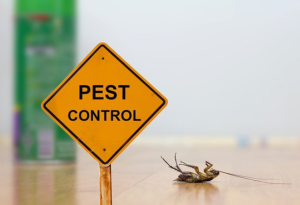Pest control is the practice of preventing or eliminating pests. It involves evaluating pests and their environment and establishing controls that minimize harm to people and property.
Prevention includes keeping a hygienic home, regularly cleaning and removing garbage, and limiting the areas where pests can hide. It also includes eliminating sources of food and water and repairing leaky plumbing. Contact Pest Control Boston now!

Prevention is the best way to deal with pest infestations. This involves eliminating attractants that draw the pests into facilities and reducing the conditions that give them an edge in entering. In food plants, this means promptly removing trash and keeping the area clean and tidy, sealing cracks in buildings, and keeping doors and windows closed. It also means implementing a system for inspecting deliveries and other items brought into the facility, then following the appropriate action steps to prevent them from entering.
Another good preventive measure is to use the right container for each item and keep it in a protected place during transport or storage. This reduces the chances of pests gaining access to the contents, which can result in adulteration. It also helps ensure that containers are sealed tightly enough to prevent the release of odors that can attract pests.
In homes, the most effective preventive measures are to vacuum and sweep frequently, clean spills promptly, wipe down counter tops, and store all foods in the refrigerator in airtight containers. Keep garbage cans tightly closed, and be sure to know the correct day to take out trash.
If you find a pest infestation in your home, it is important to follow the guidelines on safe and effective use of any chemical treatments that may be recommended by a professional. The goal is to cause as little harm as possible to both the pest and other organisms in the environment, so care should always be taken when using any chemicals.
For commercial facilities, preventing pest problems is even more crucial. Food-contaminating pests can cause serious health hazards, including food poisoning. They can also damage equipment and spoil goods, as well as cause fires by chewing through wiring. The best way to protect your facilities is through integrated pest management (IPM), which focuses on preventive methods such as caulking, landscape modification, and modifying cultural practices. IPM also includes monitoring and uses controlled releases of pesticides only when a threshold is exceeded. Thresholds are based on the number of pests and their impact, rather than a set time period, so you can determine when to act.
Suppression
Suppression methods restrict pest activity and population growth, usually to prevent an outbreak. Monitoring, identification, and evaluation are critical steps in determining the severity of damage and selecting control methods. Identifying the pest responsible for the problem, understanding its life cycle, and evaluating the environmental conditions that led to the outbreak will guide control efforts.
Biological Controls involve the use of living organisms, natural enemies (predators, parasitoids and pathogens) that injure or consume pests or reduce their numbers. Increasing the number of predators, parasitoids and pathogens through conservation or inundative releases can effectively control pest populations.
There is often a time lag between the increase in the number of natural enemies and their impact on pests, so biological controls do not provide immediate or complete protection from pests. For successful biological control, it is essential to choose suitable enemies that are adapted to the environment and to understand how they work with other elements of the ecosystem, such as soil fertility and water availability.
Cultural Controls are practices that alter the conditions that favor pest infestations. Plowing, crop rotation, removing infested plant material, cleaning greenhouse and tillage equipment, and adjusting irrigation schedules can all deprive pests of comfortable habitat or prevent them from spreading.
Physical Controls are tools and techniques that physically deprive or confine pests, such as glue traps in homes for fruit flies, red sphere traps for codling moth larvae, and cardboard bands wrapped around apple trees to keep cutworms from piercing the bark. Other physical controls include swatting flying insects, blowing or shaking plants to dislodge them, and spraying trees with soapy water to knock out aphids and mites.
Chemical Controls involve the use of synthetic or organic chemicals that either directly kill or debilitate pests. Some chemical control agents act as deterrents or disrupt pest metabolism, and others suppress or inhibit their growth or reproduction. Chemicals must be selected carefully, based on the frequency and duration of their use, to ensure that they do not harm other beneficial organisms or the environment.
Some pests are considered a public health or environmental threat and cannot be allowed to exist in a particular environment. Eradication or elimination of the pest is the goal in these cases. This can be accomplished through regulatory control, including quarantine and eradication procedures, coordinated by local or state authorities.
Eradication
The goal of eradication is to reduce or eliminate the population of pests to the point that they no longer threaten the ecosystem or human health. Eradication is a step up from suppression and differs from extirpation, annihilation or uprooting. The term exterminate, meanwhile, refers to a more drastic action like hitting the pest with a hammer or bombing it to the point of destruction or driving it out of an area by force.
Biological eradication involves using natural enemies to control pests. This can include introducing predators and parasitoids to the environment or releasing them there in large numbers. It also can involve supplying the enemy with its own food (seeds or pollen). This is one of the oldest forms of pest control and is used extensively in agriculture. It may also be used in home or garden settings.
Insects, ants and mice are common pests that need to be controlled. Their presence can damage buildings and gardens, cause discomfort, interfere with food storage or cooking, create unpleasant odors, stain and discolor personal items and destroy clothing and furniture. Pests can carry and spread diseases that affect humans, livestock or pets, and they can contaminate foodstuffs and water supplies.
Some pests have a frightening or grotesque appearance, such as spiders and silverfish, and they can bite or sting people, livestock or pets. Others stain or contaminate clothing and other items, such as boxelder bugs, house centipedes and earwigs. Still others are a nuisance or a serious annoyance, such as cockroaches, bed bugs and mice.
One method of pest control is to spray the infested area with chemicals. This can be done by a professional pest control company, who will first inspect the premises and locate nests or entry points. Then, they can recommend the best course of action.
Another method is to use physical barriers to prevent access by pests, such as weather stripping around doors and windows, and putting up screens or wire mesh over openings in the walls. Planting naturally repelling plants like lavender, basil, or catnip can also help deter pests in your garden and landscape.
Monitoring
Pest monitoring is an important part of a proactive IPM program. It involves regular searching for, identifying, and assessing numbers of pests and the damage they are causing. It also includes tracking environmental conditions that may influence pest populations, such as weather and food or harborage availability. These monitoring activities, when done consistently, serve as an early warning system, allowing facility staff to take preventive action before a pest infestation gets out of control.
The pest identification process is important for determining what type of pest you are dealing with so that the proper treatment can be selected. It is also helpful in predicting when and how often treatments will be needed. This information can then be used to develop a schedule for pest management. The monitoring process also helps track the effectiveness of the treatments and allows for adjustment of control tactics as necessary.
Once a pest problem is under control, follow-up visits are important to ensure that the situation stays that way. These visits allow your pest control company to inspect for signs of pest activity, treat any new occurrences, and recommend adjustments to reduce attractants or create barriers. This will help protect the integrity of your home and help prevent future infestations.
Monitoring is especially critical in cultural heritage facilities. In addition to tracking pest pressures and their conducive environmental conditions, these sites must also monitor for the presence of natural enemies that can keep pest populations under control. Monitoring for these organisms is important so that if pesticides are necessary, they can be used in a very targeted manner and with fewer environmental impacts.
Routine pest control services can be a valuable investment for homeowners, businesses, and public and private institutions. By keeping pests under control, they can protect property value and prevent damage that can be costly to repair or replace. Pests can also carry diseases or allergens that pose health risks to people and animals, so eliminating them helps protect human health and safety. Additionally, many pests destroy crops and food supplies, so pest control is an essential component of food production.



